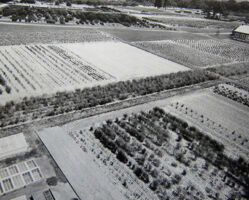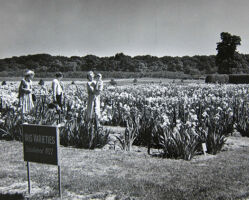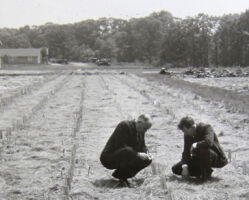
On May 17, 2016, Rutgers Gardens celebrated its centennial anniversary on the date when Jacob and Cecilia Lipman purchased the 35.7 acre Wolpart Farm and sold it to Rutgers University for one dollar. This land now constitutes the current core of the Gardens, stretching from the Hollies down to Westons Mill Pond. Interestingly, it was not purchased with the intent of creating a public garden, nor even for the public to necessarily enjoy. It was purchased to create what became known as “Horticulture Farm No. 1,” a facility dedicated to research in pomology and vegetables, with a small, 4-acre plot for ornamental horticulture.
At the turn of the last century, New Jersey planners predicted suburban housing would spread across the Hudson and Delaware Rivers from New York City and Philadelphia, respectively. It was also foreseen that the middle class would grow, along with a generous amount of free time that the machine age would generate. This free time, combined with the suburban sprawl, pointed to an increased demand for ornamental gardening and plants—a demand that the nursery industry in NJ could not support at that time. Hence, the creation of the 4-acre parcel within Hort. Farm 1, dedicated to displaying woody shrubs, along with various herbaceous plants that were popular at that time, such as Cotoneaster and Iris. Farmers ventured to Hort. Farm 1 to study the shrubs and herbaceous materials in the hopes that the growing demand for nursery crops could enhance their incomes. The balance of land for Hort. Farm 1 was dedicated to food crops. The area where the Holly Collection currently resides was dedicated to vegetable research, the area adjacent to the Bamboo Grove was for agronomy, and the balance of land by the Log Cabin eventually focused on apple and peach research. The public was invited in when the Iris was at peak bloom, but the facility was not intended to be a public garden.
The original Director of the facility was Dr. Charles Connors, and most likely, the first display area established was the Iris Garden in 1922. The initial date of the planting of the Shrub Garden is unknown, but by the mid-1930s it consisted of rows of woody plants for potential nurserymen to review.
On what is now the George H. Cook campus, the Civilian Conservation Corps barracks were established on College Farm Road, and prior to 1935 the CCC constructed the facility that is now called Holly House. It had walk-in refrigerators in the basement and was created to support the peach and apple research being conducted on Hort. Farm 1. They also constructed the small building that now sits at the back of the Sun and Shade Garden, the barn doors and foundation blocks of which are identical to those of Holly House. Lastly, in 1935–36, the CCC built the Log Cabin, at a total cost to the university of $5,000.
The 70-acre woodland known as Helyar Woods was also donated to the university during this period as part of two gifts in 1927 and 1937. The donation came with the stipulation that the wooded lot was to be preserved for the purposes of research and the study of woodland management and change. Initially, it was predominantly an American Chestnut woodland but has evolved into a Beech, Oak, Maple and Hickory woodland, following the chestnut blight. Frank G. Helyar was Director of Resident Instruction from 1929–1953. In 1961 this woodland was named in his honor.
During the mid-30s Ben Blackburn started to work at Hort. Farm 1 and he redesigned the Shrub Collection into its current form, with a large central space surrounded by shrubs. One of his most noteworthy additions was the Magnolia kobus that stood at the far end of the Shrub Garden and was affectionately called “Larry.” During a children’s tour in 2011, a Rutgers Gardens intern named KC Murry was leading a group of second graders. When a child asked for the name of the type of tree they were sitting on, KC could not remember the name “Magnolia” and blurted out “Larry!”
The late 1930s saw the creation of the Rhododendron Garden directly opposite the Iris Garden —presumably another design by Ben Blackburn. From a plant breeding standpoint, Hort. Farm 1 also served as the location for an incredible peach breeding program during the 1930s and 1940s that resurrected the peach industry in NJ. The large peach orchards of NJ had been decimated by the San Jose scale. Through the work of Dr. Maurice Blake and Dr. Charles Connors, new selections with much higher yields were developed. This allowed the farmers to have smaller farms that they could manage more efficiently, with equal or greater revenue. This period also saw the American Holly Society (AHS), located in Millville, New Jersey, impact the Gardens. They thought it would be a boon to NJ agriculture to develop a holly selection that would have the large, glossy leaves and fruit of the English Holly, with the hardiness of the American Holly. This undertaking was not to serve the nursery industry, but the cut-stem industry throughout the Thanksgiving and Christmas holidays. Starting in the late 1940s and early 1950s, the current collection of hollies (an area then called the “Holly Orchard”) was amassed to serve as germplasm for this breeding effort.
In 1955, Roy H. DeBoer came to Rutgers to pursue his Masters in Horticulture while evaluating how extending the day length with artificial light impacted plants. He worked at Rutgers Gardens until 1960, when he moved on to teaching and eventually developed the Landscape Architecture program at what is now the Rutgers School of Environmental and Biological Sciences. Among his many contributions to Rutgers Gardens was designing and installing the Evergreen Garden. The section that he chose was a depressed area across from the Rhododendron Garden that had been used as a “borrow pit,” where soil is mined for alternate uses. Roy designed it as an outdoor room, with a Weeping White Pine serving as the central point of interest. The plant material was donated by various nurseries throughout the state. In October 1997, it was officially renamed the Roy H. DeBoer Evergreen Garden.
As Roy DeBoer was moving on to teaching, Dr. Elwin Orton was just arriving. The peach and apple research had been moved to other locations, and in July 1960, Dr. Orton began his work of developing the dream holly for the American Holly Society. Dr. Orton did worked on not only crossing the American Hollies (Ilex opaca) with English Hollies (Ilex aquifolium), but also on crossing Japanese Hollies (Ilex crenata), Firethorn (Pyracantha), Benjamin Franklin Tree (Franklinia) and Dogwoods (Cornus). Unfortunately, the crosses the AHS had hoped to see did not materialize, since the resulting progeny were sterile. However, the crosses between the American and Chinese Dogwoods yielded fantastic results and are much sought after by gardeners both in the US and abroad.
The early 1960s also saw the beginning of financial constraints and the end of the Iris Collection in 1963. The costs of digging and dividing the collection—not to mention weeding—had become excessive. In 1964, Donald B. Lacey, an Extension Specialist in Ornamental Horticulture proposed using part of this area as a display garden for annuals. He scoured the weather documents for July and determined that the last Saturday of the month was historically the least prone to rain. In July 1965, the first Open House was held.
Throughout the 1970s and into the 1980s, the staff at Hort. Farm 1 continued to dwindle, although both Dr. Orton and Mr. Lacey continued their efforts. It was a relatively quiet time at the Gardens, with one auspicious flurry of activity on April 27, 1981. Rutgers officials and the Garden Club of New Jersey (GCNJ) joined together to celebrate the official opening and dedication of Holly House, formerly Horticulture House, as the GCNJ headquarters. The architectural plans were originally drafted by Robert Green, husband of a GCNJ board member and member of the Headquarters Committee. Plans were finalized by Rutgers Architect Bertelson, with construction occurring during the fall of 1980.
Having GCNJ headquarters move into Holly House proved to be very fortuitous. The building started to regain a true purpose, as it was vacant for a number of years. Having the GCNJ on site also provided a potential new source of help. Dr. Bruce Hamilton of the Landscape Architecture department became the next Director of the Gardens in 1989. With a limited staff and reduced budget to care for the Gardens, Dr. Hamilton relied on the support of the GCNJ and the public through plant sales, donations, and volunteerism to maintain the Gardens. The Log Cabin was rented as an event site to university departments and to the public during the late 1990s, and the Cook Community Alumni Association donated the Log Cabin Pavilion structure and enlarged the septic system during this same period. The Pavilion was the inspiration of the very popular Dean of Students, Dr. Roger Locandro, who held an annual fish fry at the cabin.
From 2005 to present, a number of new garden additions were built, including the Otken Garden, Rain Garden, and Pollinator Garden. Each was supported by donors, with an intentional mission for its creation. In the summer of 2007, Dr. Robert M. Goodman, Executive Dean of the Rutgers School of Environmental and Biological Sciences, further expanded the public areas of Rutgers Gardens to include Helyar Woods, research land, and the sections along Route 1. Rutgers Gardens grew in size to 180 acres.
Rutgers Gardens has witnessed over 100 years of change and development that has been shaped by a great number of scientists, horticulturists, and garden lovers.


